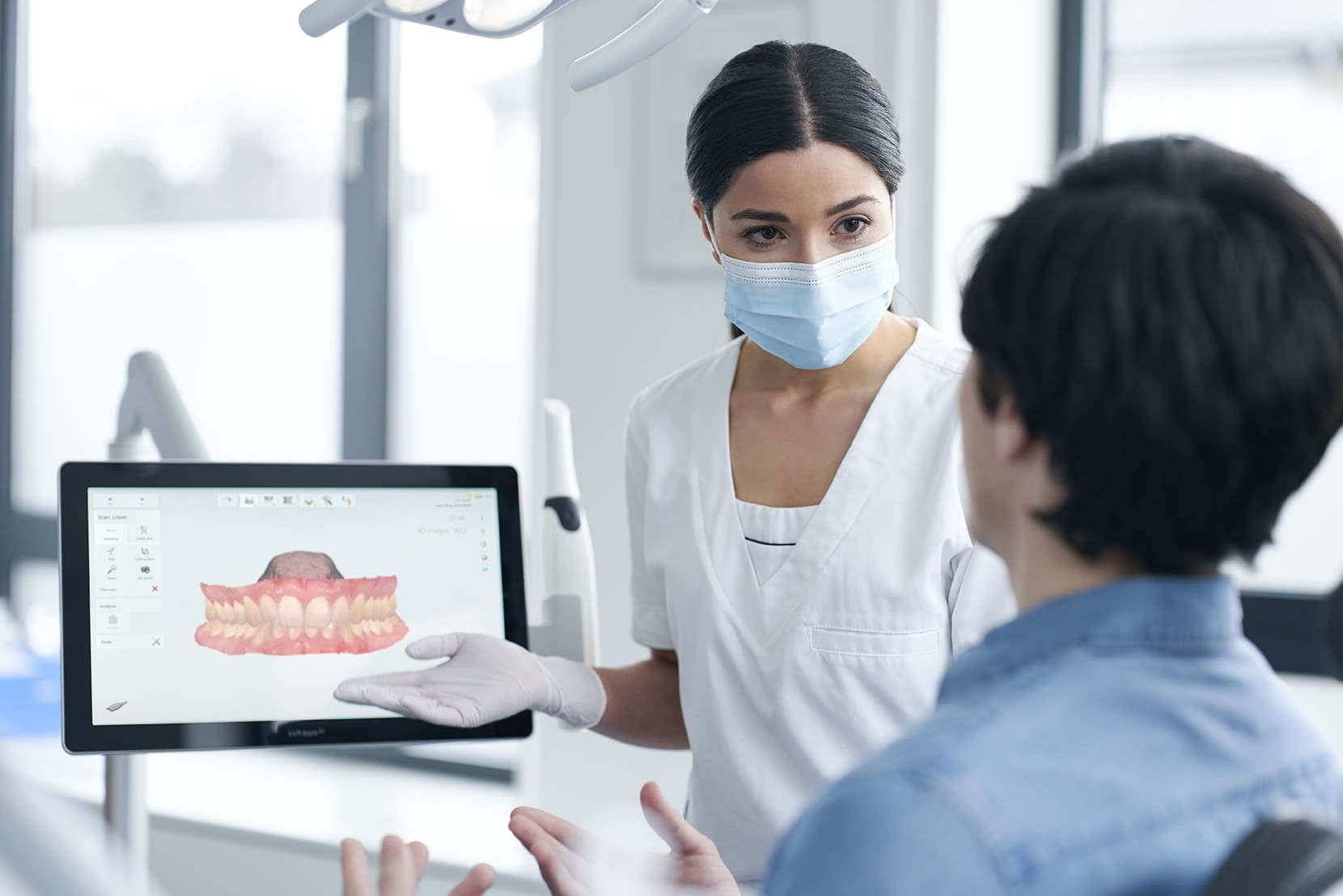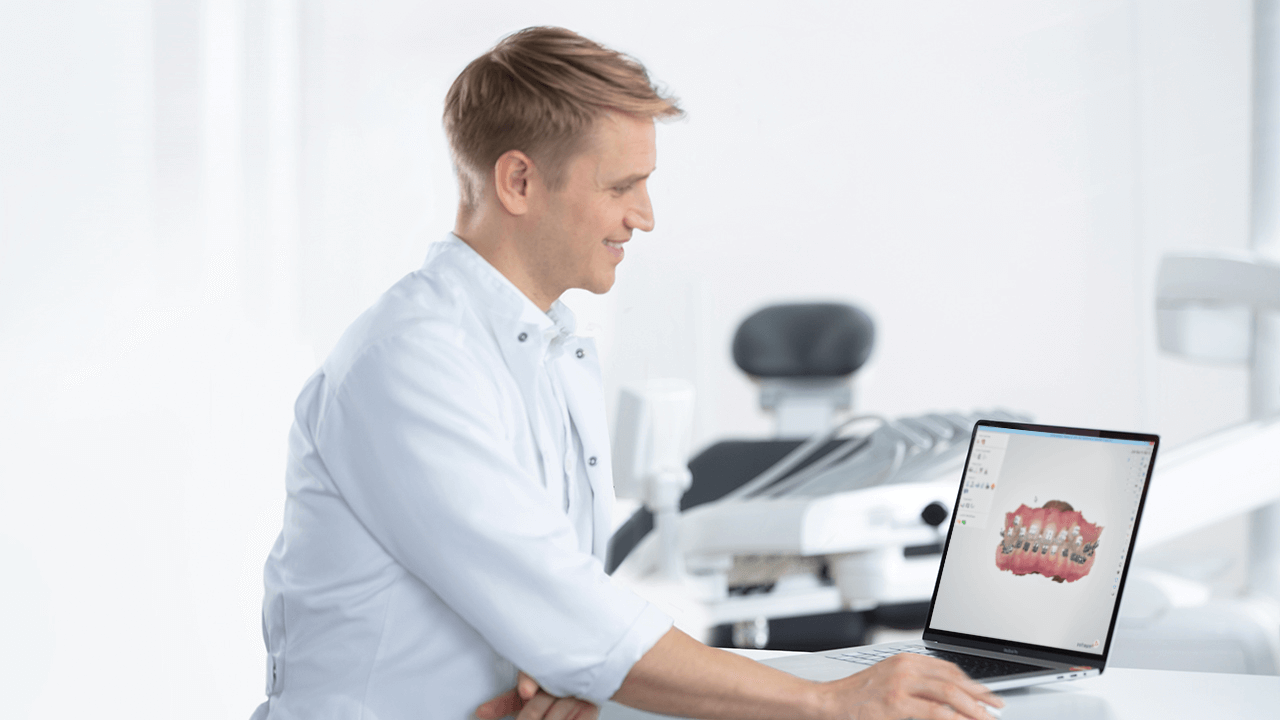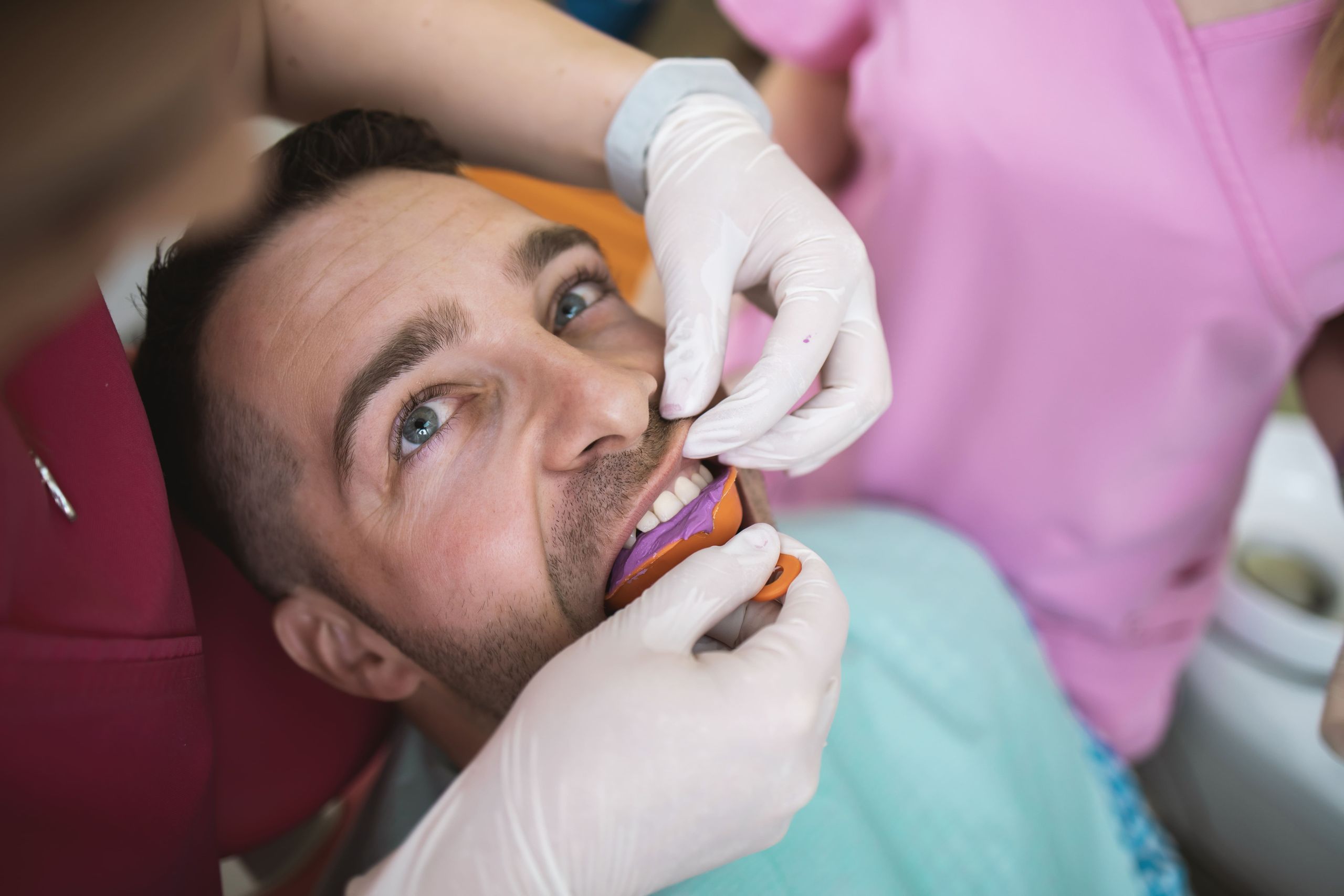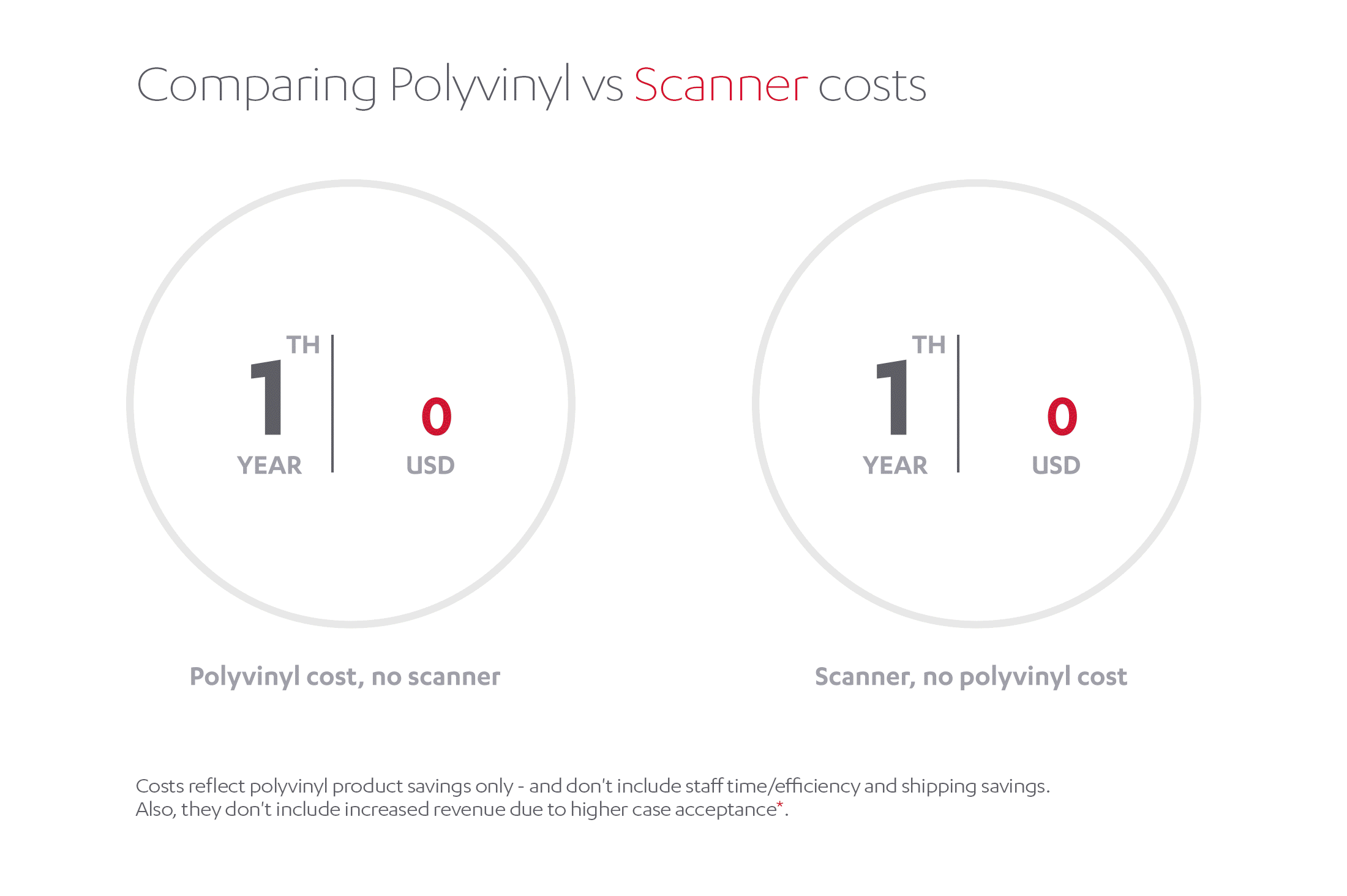- Home
- Blog
- Digital dentistry
- Digital Impressions
What are digital impressions and how do they work?
Digital dental impressions are becoming a more and more popular alternative to conventional ones in dental clinics all over the world. The result is often a quicker and less invasive impression procedure, more accuracy and easier workflows. This benefits doctors, labs and patients. What are digital impressions, are they better than conventional ones, and why aren’t all doctors working with them yet? Let's find out.
What is a digital impression?
Digital impressions are dental scans taken with 3D scanning technology. The digital impression system captures the dentition with the use of polygons (triangles) and by that, it helps build up a highly accurate 3D image of the patient’s dentition. There are different ways of getting to a digital impression: either a desktop scanner scans a gypsum model to generate a digital model, or an intraoral scanner generates a digital impression directly from the patient’s oral cavity. Intraoral scanning creates digital replicas of teeth and gums, and displays the result directly on a computer or tablet screen. The dental specialist can then use these digital teeth impressions for assessing whether there is a problem, what it is, what treatment could be required, and communicating about all this with the patient.

What are digital impressions used for?
Digital dental impression systems were originally used to create a digitized image that would serve as a starting point for the design of a restoration. It would be used for simple treatments like a single crown placement, or for more extensive restorative procedures (a fixed bridge or creating full dentures).
Dr. Jonathan L. Ferencz says that ‘he most commonly uses digital impressions for same-day restorations’.
Here are some other cases where digital impressions can be used (and the list grows longer and longer, the more advanced digital dentistry is becoming):
- Dentures creation (complete, partial, immediate)
- Teeth alignment planning (braces, clear aligners, and other appliances)
- Splints, mouth guards or dental sleep devices
- Dental implants placement
- Performing guided surgery
- Preventative dentistry (monitoring)
- Caries detection
How long does it take to take a digital impression?
The time it takes to take the impression scan in the mouth depends, first of all, on the digital impression machine itself — scanner specifications differ from manufacturer to manufacturer. The next factor to consider is the case at hand. Scanning for a clear aligner treatment for example, is different from scanning only one specific area. And even scanning for the same case can be different from patient to patient, depending on the complexity of the individual case. Another thing to keep in mind is the dental specialist’s experience in using digital impression technologies. A study was performed among dental students of Semmelweis University who used a 3Shape TRIOS 3 scanner to compare the total time it took to scan and the number of images. It showed a significant difference between time needed for taking the first and 10th impression for each student — the time was decreasing remarkably 1. Róth I, Czigola A, Joós-Kovács GL, Dalos M, Hermann P, Borbély J. Learning curve of digital intraoral scanning - an in vivo study. BMC Oral Health. 2020 Oct 19;20(1):287. doi: 10.1186/s12903-020-01278-1. PMID: 33076894; PMCID: PMC7574448..
From our own experience we can say that a full-arch impression can be taken in as little as 40 seconds, including bite alignment. But we must add to that 40 seconds is only realistic to aim for with extensive experience.
Digital impression technique in dentistry
Initially, digital impression techniques 2. Ting-Shu S, Jian S. Intraoral Digital Impression Technique: A Review. J Prosthodont. 2015 Jun;24(4):313-21. doi: 10.1111/jopr.12218. Epub 2014 Sep 14. PMID: 25220390. were used in the field of prosthodontics for the fabrication of dental prostheses. Clinical studies showed that dental prostheses made with the help of this technology 3. Nedelcu R, Olsson P, Nyström I, Rydén J, Thor A. Accuracy and precision of 3 intraoral scanners and accuracy of conventional impressions: A novel in vivo analysis method. J Dent. 2018 Feb;69:110-118. doi: 10.1016/j.jdent.2017.12.006. Epub 2017 Dec 12. PMID: 29246490. showed more accuracy in comparison with traditional impressions.
These good results contributed to the fact that digital impression scanners are becoming more and more mainstream in various fields of dentistry, usually with labs taking the lead and their practices following suit after.
Dental specialists that were first-movers are even developing and promoting specific impression taking protocols and techniques 4. Fernandes A, Dua N, Herekar M. Corrective primary impression technique. Open Dent J. 2010 Apr 14;4:27-8. doi: 10.2174/1874210601004010027. PMID: 20502648; PMCID: PMC2874218., for instance, there is a corrective primary impression technique and a strategy for scanning fully edentulous patients.
If we look at the process of taking digital impressions in general we will see that there are a few common steps 5. Yuzbasioglu E, Kurt H, Turunc R, Bilir H. Comparison of digital and conventional impression techniques: evaluation of patients' perception, treatment comfort, effectiveness and clinical outcomes. BMC Oral Health. 2014 Jan 30;14:10. doi: 10.1186/1472-6831-14-10. PMID: 24479892; PMCID: PMC3913616., and they all are fully digitalized:
- First — entering patient information into the scanner software;
- Second — scanning upper and lower arches;
- Third — right and left bite scanning;
- Fourth — sending results to the person working on the design or treatment plan.
Let’s see how digital impressions are taken in different fields of dentistry.
Digital impressions in orthodontics
Orthodontists use digital impressions to create 3D models of the position of the teeth for proper treatment planning and correct placement of the treatment appliances.They either scan the patient directly or they digitize a gypsum model with a desktop scanner. Once the digital model is created, an orthodontist can open it in dedicated orthodontic planning software to determine the most accurate and functional way to place braces, clear aligners, or other retainers, in order to get the desired outcome. In some cases, an orthodontist will choose to combine digitally taken impressions with 3D panoramic X-ray. They do this in order to ensure there are no anatomical problems before initiating treatment.

Digital impressions for dentures
Digital denture creation always starts with impression taking, either in conventional or digital form. Even though the conventional way is still the default for most dentists and denturists, digital impressions are becoming more and more popular, because digital can enable a faster, more comfortable and cheaper workflow. A digital impression can (as for other indications) be taken from a gypsum model or impression tray with a desktop scanner, or directly with the patient, with an intraoral scanner. Taking a scan directly from an edentulous patient was previously seen as challenging, because of the soft tissue. The soft tissue and vestibular area of edentulous patients is moveable, which makes it hard for the scanner to capture. However, scanners are becoming better and better in capturing the movement of the soft tissue and research now shows that fully digital impressions for complete dentures can provide great outcomes 6. Fang JH, An X, Jeong SM, Choi BH. Development of complete dentures based on digital intraoral impressions-Case report. J Prosthodont Res. 2018 Jan;62(1):116-120. doi: 10.1016/j.jpor.2017.05.005. Epub 2017 Jun 16. PMID: 28625663. The right technology combined with the right scan technique seems to make the way for entirely digital denture workflows, even for fully edentulous patients.Digital implants impressions
Digital impressions can also be used to plan where to place the implants for the best prosthetic outcome. This is called Prosthetically Driven Implant Planning. This digital implant impression usually needs to be combined with a cone beam scan in order to get the full picture and start treatment planning. Once the design is validated, the doctor aligns the (digital) impression and the x-ray scan, and presents the patient with the treatment plan. When the doctor chooses to do a fully digital workflow, they may opt to use their digital implant scan for creating a surgical guide, too. The use of a guide during surgery to some doctors means a safer procedure that will reduce operating time.
Digital impressions vs. traditional impressions
Even with 3d digital dental impressions and digital dentistry in general being on the rise, there are still many dentists that prefer conventional impression taking methods. Alginate is the most used material for traditional impressions. Even though the process of taking alginate impressions is not a painful medical procedure, patients do need to sit for multiple minutes or longer. In a chair, holding a lump in their mouth that tastes and smells unpleasant. It is not a secret that impression taking in this way can create unpleasant associations with going to the dentist. In addition, the impression taking procedure can cause gag reflex and even vomiting in some patients, which can complicate the acquisition of an impression the acquisition of an impression.

Digital dental impression technology with an intraoral scanner completely eliminates the need for alginate material, gag reflex, and other associated discomfort. Additional advantages of intraoral impressions which dental specialists and patients will relate to:
- Decrease of cross-infection risks related to the transmission of conventional impressions between labs and clinics.
- Accuracy when using intraoral scanners for digital impressions seems to be on par or even higher than for conventional impressions, according to many different studies that we’ve compiled into one ebook 7. 3Shape Scientific Research Overview Clinical Affairs, 2020: 34 clinical studies report statistical superior accuracy with TRIOS (2017-2019) Digital Versus Conventional Impressions in Dentistry: A Systematic Review, Chandran et al. 2019: Journal of Clinical & Diagnostic Research: 67% of (16 of 24) studies show digital impressions are more accurate (in microns) as conventional. 92% of (22 of 24) studies show the same level of clinical acceptability as conventional..
Software for processing digital scans will immediately show issues (like tooth wear, potential caries, deformities) that can influence the proper fit of restorations, dentures, appliances, etc. Accidental air bubbles will not break the mold material as sometimes happens with conventional impressions. Retakes are not necessary. - Digital impressions save time for patients and dental specialists 5. Yuzbasioglu E, Kurt H, Turunc R, Bilir H. Comparison of digital and conventional impression techniques: evaluation of patients' perception, treatment comfort, effectiveness and clinical outcomes. BMC Oral Health. 2014 Jan 30;14:10. doi: 10.1186/1472-6831-14-10. PMID: 24479892; PMCID: PMC3913616.. It doesn’t only reduce time spent in the dental chair but can also reduce the number of visits, depending on the treatment.
Patients seem more likely to accept the need for treatment when it’s visualized for them on screen with the help of a 3D model. Cost savings for the doctor: there is no more need to buy impression material and ship models back and forth. This doesn’t only save money, it also reduces CO2 footprint.
How much does a digital dental impression cost?
From a patient point of view, digital dental impressions costs will not differ from conventional impression costs. Currently, the average cost of dental impressions done with a conventional stick tray varies between $20 and $40, as we've calculated them for our ROI Calculator that uses all available data on impression material and time needed. A disadvantage of digital impressions for the dentist could however be the initial investment costs. Implementing the hardware and the software in the practice, plus training staff to use it in the right way, does take time and money. Investment costs are between $20,000 and $50,000 depending on the model, the hardware setup, software and additional treatment options the doctor prefers. But there are several reasons to believe that even though initial dental impressions cost is high, it will be very profitable for doctors in the long run. Some dentists have reached break even point after 3 months already due to:
- The time required to create and process an impression is reduced when taking an intraoral scan, which means that the clinic will be able to produce more orders per unit of time.
- Digital technology and treatments are more appealing to patients, which means the clinic can attract more new clients and more new orders.
Dr. Naren Rajan from “Dentistry of Mendham” in New Jersey, USA analyzed the financial impact of digital impressions on his business and found out that they have shown positive effects on overall productivity and number of visits.

If you are a dentist and still have doubts about the benefits of investing in digital dentistry, you can use the 3Shape ROI Calculator and see personal benefits.
Resources
- Róth I, Czigola A, Joós-Kovács GL, Dalos M, Hermann P, Borbély J. Learning curve of digital intraoral scanning - an in vivo study. BMC Oral Health. 2020 Oct 19;20(1):287. doi: 10.1186/s12903-020-01278-1. PMID: 33076894; PMCID: PMC7574448.
- Ting-Shu S, Jian S. Intraoral Digital Impression Technique: A Review. J Prosthodont. 2015 Jun;24(4):313-21. doi: 10.1111/jopr.12218. Epub 2014 Sep 14. PMID: 25220390.
- Nedelcu R, Olsson P, Nyström I, Rydén J, Thor A. Accuracy and precision of 3 intraoral scanners and accuracy of conventional impressions: A novel in vivo analysis method. J Dent. 2018 Feb;69:110-118. doi: 10.1016/j.jdent.2017.12.006. Epub 2017 Dec 12. PMID: 29246490.
- Fernandes A, Dua N, Herekar M. Corrective primary impression technique. Open Dent J. 2010 Apr 14;4:27-8. doi: 10.2174/1874210601004010027. PMID: 20502648; PMCID: PMC2874218.
- Yuzbasioglu E, Kurt H, Turunc R, Bilir H. Comparison of digital and conventional impression techniques: evaluation of patients' perception, treatment comfort, effectiveness and clinical outcomes. BMC Oral Health. 2014 Jan 30;14:10. doi: 10.1186/1472-6831-14-10. PMID: 24479892; PMCID: PMC3913616.
- Fang JH, An X, Jeong SM, Choi BH. Development of complete dentures based on digital intraoral impressions-Case report. J Prosthodont Res. 2018 Jan;62(1):116-120. doi: 10.1016/j.jpor.2017.05.005. Epub 2017 Jun 16. PMID: 28625663.
- 3Shape Scientific Research Overview Clinical Affairs, 2020: 34 clinical studies report statistical superior accuracy with TRIOS (2017-2019) Digital Versus Conventional Impressions in Dentistry: A Systematic Review, Chandran et al. 2019: Journal of Clinical & Diagnostic Research: 67% of (16 of 24) studies show digital impressions are more accurate (in microns) as conventional. 92% of (22 of 24) studies show the same level of clinical acceptability as conventional.